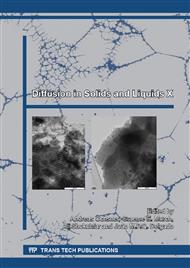[1]
Lehman, R. L et. al , Materials, Mechanical Engineering Handbook Ed. Frank Kreith , Boca Raton: CRC Press LLC, (1999).
Google Scholar
[2]
Bozkurt E, Kaya E, Tanog˘lu M. Mechanical and thermal behaviour of non-crimp glass fibre reinforced layered clay/epoxy nanocomposites. Composite Science Technology (2007); 67: 3394–403.
DOI: 10.1016/j.compscitech.2007.03.021
Google Scholar
[3]
Zulfli NHM, Shyang CW. Flexural and morphological properties of epoxy/glass fibre/silane-treated organomontmorillonite composites. J Physics Science (2010) 21: 41–50.
Google Scholar
[4]
Xu Y, Hoa SV. Mechanical properties of carbon fibre reinforced epoxy/claynanocomposites. Composite Science Technology (2008) 68: 854–61.
Google Scholar
[5]
M. Al-Qadhi , N. Merah , Z. M. Gasem, Mechanical properties and water uptake of epoxy–clay nanocomposites containing different clay loadings, J Mater Sci (2013) 48: 3798–3804.
DOI: 10.1007/s10853-013-7180-5
Google Scholar
[6]
Xi Li, Zai-Ji Zhan, Gui-Rong Peng, Wen-Kui Wang, Nano-disassembling method—A new method for preparing completely exfoliated epoxy/clay nanocomposites, Applied Clay Science 55 (2012): 168–172.
DOI: 10.1016/j.clay.2011.11.015
Google Scholar
[7]
Hong-Yuan Liu, Gong-Tao Wang, Yiu-Wing Mai, Ying Zeng, On fracture toughness of nano-particle modified epoxy, Composites: Part B 42 (2011): 2170–2175.
DOI: 10.1016/j.compositesb.2011.05.014
Google Scholar
[8]
Mohd. Zulfli, N. H., Abu Bakar A. and Chow W. S., Mechanical and Thermal behaviours of glass fiber reinforced epoxy hybrid composites containing organo-montmorillonite clay, Malaysian Polymer Journal, Vol. 7 No. 1, (2012), 8-15.
Google Scholar
[9]
Yuan Xu, Suong Van Hoa, Mechanical properties of carbon fiber reinforced epoxy/clay nanocomposites, Composites Science and Technology 68 (2008): 854–861.
DOI: 10.1016/j.compscitech.2007.08.013
Google Scholar
[10]
Mahmood M. Shokrieh, Amir R. Kefayati, Majid Chitsazzadeh, Fabrication and mechanical properties of clay/epoxy nanocomposite and its polymer concrete, Materials and Design 40 (2012): 443–452.
DOI: 10.1016/j.matdes.2012.03.008
Google Scholar
[11]
B. Akbari , R. Bagheri, Deformation mechanism of epoxy/clay nanocomposite, European Polymer Journal 43 (2007); 782–788.
DOI: 10.1016/j.eurpolymj.2006.11.028
Google Scholar
[12]
M. Al-Qadhi, N. Merah, Z. Khan, K. Mezghani and J. Adinoyi: ECCM15 – 15th European Conference on Composite Materials, Venice, Italy, 24-28 June (2012).
Google Scholar
[13]
M. Al-Qadhi, N. Merah and K. Mezghani: Key Engineering Materials Vol. 471-472 (2011): 415-419.
DOI: 10.4028/www.scientific.net/kem.471-472.415
Google Scholar
[14]
R. Velmurugan and T.P. Mohan, Epoxy-Clay Nanocomposites and Hybrids: Synthesis and Characterization, Journal of Reinforced Plastics and Composites (2009).
DOI: 10.1177/0731684407081439
Google Scholar
[15]
Weiping Liu, Suong V. Hoa, Martin Pugh, Fracture toughness and water uptake of high-performance epoxy/nanoclay nanocomposites, Composites Science and Technology 65 (2005): 2364–2373.
DOI: 10.1016/j.compscitech.2005.06.007
Google Scholar
[16]
X. Kornmann, M. Rees,Y. Thomann, A. Necola, M. Barbezat , R. Thomann, Epoxy-layered silicate nanocomposites as matrix in glass fibre-reinforced composites, Composites Science and Technology 65 (2005): 2259–2268.
DOI: 10.1016/j.compscitech.2005.02.006
Google Scholar


